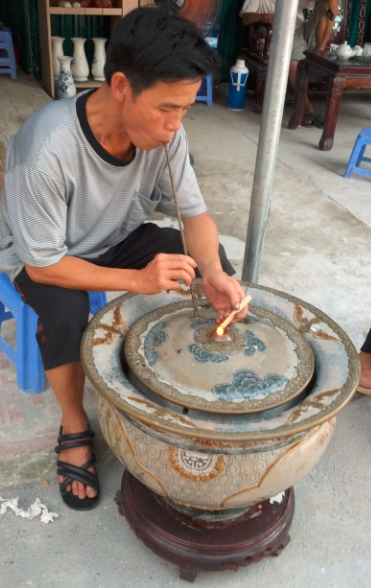This Bengali sweet makes me drooling at its name. A visit to Hauz Khas or Chandni Chowk in Delhi is never complete without a visit to Annapoorna.
It gets its name from lavang which means clove and is inserted to seal the folds. This also imparts the flavor of clove on frying. I could not however, get the Annapoorna flavor but analysed the sweet closely this time eating it slowly and trying to get hold of all its flavors.
I used to put saffron, almonds to the khoya mixture earlier but I noticed that adding nutmeg gives it a wonderful flavor.

Ingredients:
For the outer shell:
2 cups maida/ all purpose flour
4 tbsp melted ghee
1/2 tsp baking powder
Filling:
1 cup mawa or khoya
1 tsp nutmeg powder
1/4 tsp mace powder
a pinch of clove powder
1/4 tsp cardamom powder
For the sugar syrup:
1 cup sugar
1/2 cup water
1/2 tsp of lemon juice
Method:
Sieve flour with baking powder and rub in ghee.

Add hot water a little at a time to make it into a soft dough.
let it rest for 30 minutes.
Meanwhile, make the filling.
To mawa , add nutmeg, mace, clove powder and cardamom powder. Mix properly to make a homogenous mixture.
Make a sugar syrup by adding sugar and water and give it a boil. Add lemon juice if desired.
Now, knead the dough to make it soft and pliable.
Take golf sized dough, roll and put a spoonful of filling in the center.
Fold in by bringing the sides down and overlapping one over other, Press them slightly.
Get hold of another fold and cover the earlier one.
Seal the folds by inserting a clove.
Press the lavang latika slightly to remove any air trapped inside.
Heat ghee and fry in medium heat till evenly browned.
Dip in hot syrup, leaving them for some time. Take them out and cool. Finally, they are there to devour, I can't wait to eat them.
My notes:
It gets its name from lavang which means clove and is inserted to seal the folds. This also imparts the flavor of clove on frying. I could not however, get the Annapoorna flavor but analysed the sweet closely this time eating it slowly and trying to get hold of all its flavors.
I used to put saffron, almonds to the khoya mixture earlier but I noticed that adding nutmeg gives it a wonderful flavor.

Ingredients:
For the outer shell:
2 cups maida/ all purpose flour
4 tbsp melted ghee
1/2 tsp baking powder
Filling:
1 cup mawa or khoya
1 tsp nutmeg powder
1/4 tsp mace powder
a pinch of clove powder
1/4 tsp cardamom powder
For the sugar syrup:
1 cup sugar
1/2 cup water
1/2 tsp of lemon juice
Method:
Sieve flour with baking powder and rub in ghee.

Add hot water a little at a time to make it into a soft dough.
let it rest for 30 minutes.
Meanwhile, make the filling.
To mawa , add nutmeg, mace, clove powder and cardamom powder. Mix properly to make a homogenous mixture.
Make a sugar syrup by adding sugar and water and give it a boil. Add lemon juice if desired.
Now, knead the dough to make it soft and pliable.
Take golf sized dough, roll and put a spoonful of filling in the center.
Fold in by bringing the sides down and overlapping one over other, Press them slightly.
Get hold of another fold and cover the earlier one.
Seal the folds by inserting a clove.
Press the lavang latika slightly to remove any air trapped inside.
Heat ghee and fry in medium heat till evenly browned.
Dip in hot syrup, leaving them for some time. Take them out and cool. Finally, they are there to devour, I can't wait to eat them.
My notes:
- I do not add any sugar to mawa mixture. The sugar caramelizes while frying and makes the filling hard.
- Adding lemon juice prevents sugar syrup crystallize. You can avoid adding lemon juice. I prefer my lavang latika to have a shiny appearance.
- Kneading with hot water makes the dough much soft.














































